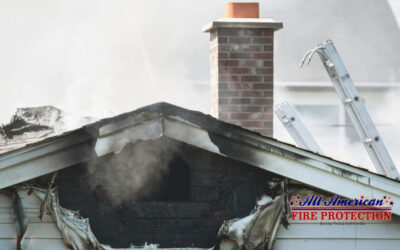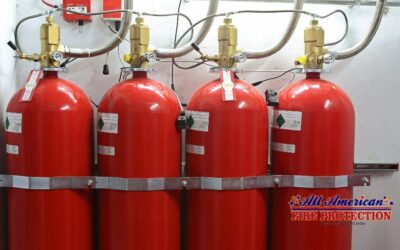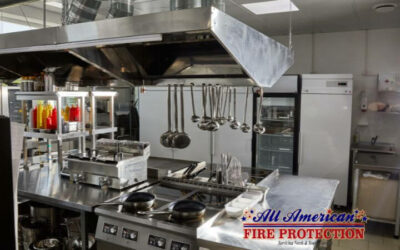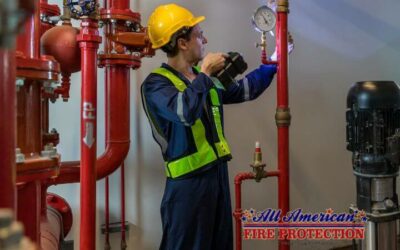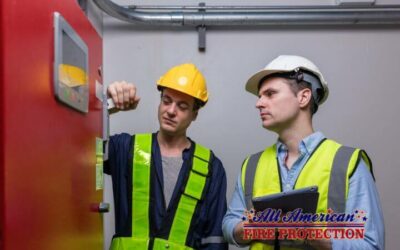Restaurant and kitchen environments are hotspots for a variety of fire hazards. One primary risk comes from the buildup of grease on surfaces like stovetops, exhaust hoods, and various cooking equipment. This accumulating grime isn’t just unappealing to look at, but can turn into a fiery disaster if not promptly addressed. Interestingly enough, even though many might not realize it, keeping your cooking space sparkling clean is an effective way to reduce the chances of fires. All American Fire Protection specializes in kitchen suppression systems, offering an essential layer of protection against fires caused by grease buildup. Now, let me tell you more about that unexpected hazard lurking in your kitchen—grease buildup, and how All American Fire Protection can safeguard your establishment from such risks.
Common fire hazards in restaurants and kitchens include grease buildup on cooking equipment, electrical malfunctions, improper storage of flammable materials, and lack of regular maintenance on fire suppression systems. It’s vital for restaurant owners and staff to be aware of these hazards and take proactive measures to prevent potential fires.
Common Fire Hazards in Restaurants and Kitchens
Grease Buildup When you consider the heat generated by stoves and ovens in a restaurant or kitchen, it’s easy to understand how grease can become a major fire hazard. Over time, the residue from cooking accumulates on stovetops, exhaust hoods, and cooking equipment. This grease buildup transforms into a sticky fuel that can ignite with a simple spark—an extremely dangerous situation. Inconsistent cleaning and maintenance routines allow the buildup to pose a significant fire risk.
It may seem like a minor duty next to preparing meals and serving customers. However, consistent cleaning of grease-prone areas is vital in preventing fire hazards from developing. Even more crucial is ensuring there is no clutter or leftover items that could easily catch fire in adjacent areas.
Electrical Failures In a busy restaurant or kitchen, electrical appliances and equipment are the lifeblood of operations. But faulty wiring, overloaded circuits, or damaged appliances can all contribute to electrical fires. With the constant influx of staff plugging and unplugging various devices throughout the day, the risk of damaging wiring increases significantly.
To minimize this threat, regular inspections by qualified personnel are paramount to assess the conditions of electrical systems within kitchens. It’s also important to ensure that kitchen staff follows all manufacturer’s guidelines when operating, maintaining, and storing electrical devices.
Combustible Materials Restaurants and kitchens are filled with flammable materials such as paper towels, packaging items, and curtains. These everyday objects might seem benign but can quickly turn into potent fire hazards when left near open flames or hot surfaces.
Proper storage practices are crucial in managing these risks. Segregating combustible materials away from heat sources, as well as providing proper training for staff to handle and store them appropriately, is necessary for mitigating this hazard.
Understanding these major hazards serves as a fundamental step toward establishing effective fire prevention protocols in restaurants and commercial kitchens. By recognizing these risks and implementing proactive measures to manage them, we can enhance safety and protect lives and property in these critical environments.
Susceptibility of Kitchens & Restaurants to Fires
Kitchens are like a well-choreographed dance; with a flurry of activity, the hiss and sizzle of food cooking, and a team making sure everything comes together just right. However, amid all this motion, a kitchen is akin to a high-stakes environment when it comes to fire hazards. The combination of high temperatures, constant equipment use, and the bustling environment makes it a hotspot for potential fire threats.
High Temperatures: The work environment in commercial kitchens involves using various heat-producing equipment such as grills, deep fryers, and ovens. The constant cooking processes result in soaring temperatures—creating an elevated risk of accidental ignition due to the combustible nature of the materials commonly used in these environments.
Frequent Equipment Use: Restaurants and commercial kitchens see frequent use of heat-generating appliances and tools. Prolonged use of stoves, ovens, grills, and deep fryers increases the probability of equipment-related fires. It’s like racing cars on a track—all it takes is one slip-up for things to take a dangerous turn.
Busy Environment: The hustle and bustle can sometimes lead to oversight of critical fire safety measures. Workers may get absorbed in their duties during peak hours or overlook early warning signs, which could result in delayed response time in the event of an emergency.
Imagine a busy evening at a restaurant where orders are flying in, chefs are multitasking, waitstaff are bustling from table to table—amidst all this chaos, it’s easy for things to be missed or overlooked.
The susceptibility of commercial kitchens to fires underscores the importance of implementing proactive fire prevention strategies. Regular staff training on fire safety procedures, routine equipment maintenance checks, and maintaining clear evacuation routes are all crucial components for ensuring the safety of everyone on-site.
In essence, by recognizing these specific vulnerabilities present in kitchen environments, restaurants and other food service establishments can better equip themselves to prevent potential devastating outcomes—an essential element in maintaining both safety protocols and business operations.
Before we look into how to bolster your kitchen’s defenses against such formidable threats, consider that knowledge truly is power when it comes to securing these hotspots from potential disasters.
Essential Fireproofing Measures
Let’s start with regular equipment maintenance. The heart of a kitchen is its hardworking equipment—ovens, stovetops, fryers, and grills—and ensuring they are meticulously maintained is paramount in fire prevention.
Scheduled maintenance not only promotes the functionality and longevity of kitchen equipment but also minimizes the risk of grease buildup, a major contributor to kitchen fires. This buildup can occur on exhaust systems and cooking surfaces and lead to dangerous flash fires. Regular cleaning helps to mitigate this risk by reducing the accumulation of flammable grease.
Proactive routine inspections and cleanings also serve as an early-warning system against electrical malfunctions, which can lead to shorts, sparks, or arcing in kitchen appliances. Therefore, establishing a consistent maintenance schedule for all kitchen equipment is vital in creating a safer environment for both employees and patrons.
Next up is the installation of fire-rated materials. During the construction or renovation of kitchens and restaurants, it’s prudent to opt for wall and ceiling materials that have been tested and certified as fire-resistant. The use of these specialized materials acts as a preventive barrier, mitigating the spread of fires should they occur.
In addition, employing fire-resistant flooring dramatically reduces the risk of flames spreading through the establishment. Particularly useful materials include ceramic tiles, concrete, or other non-combustible flooring options that impede the rapid progression of fires.
Efficient waste management emerges as another critical aspect of fireproofing measures. Proper disposal of potentially flammable waste such as grease, rubbish, and other combustible materials in designated fire-resistant containers is essential. Implementing this approach serves to contain the hazards presented by these substances while also maintaining a clean and organized workspace.
It’s fundamental to designate specific areas for the disposal of flammable waste material that are a safe distance away from the building itself. This simple precaution significantly reduces the risk of accidental fires caused by improperly handled or stowed flammable materials.
By systematically incorporating these fireproofing measures into kitchen and restaurant operations, owners and staff can significantly enhance overall fire safety, minimizing potential risks and preserving both property and patron safety.
Now that we have established essential fireproofing measures in restaurants and kitchens, let’s explore the critical role of smoke & heat alarm systems in detecting fires swiftly.
Role of Smoke & Heat Alarm Systems
Picture this: you’re in a bustling restaurant, with clattering noises and sizzling smells filling the air. Suddenly, there’s a slight whiff of smoke from the kitchen. In mere seconds, a sophisticated smoke and heat alarm system detects the anomaly and sets off a noticeable siren, alerting everyone to the potential fire hazard. This early alert system plays a pivotal role in fire prevention by immediately bringing attention to possible outbreaks and allowing for swift action to mitigate the danger.
The key feature of these systems is their ability to recognize even the earliest signs of smoke or excessive heat due to a fire. With an interconnected network of alarms placed strategically throughout the restaurant, any unusual spikes in temperature or smoke levels are rapidly identified and communicated. It’s akin to having an extra set of vigilant eyes that work around the clock, continuously monitoring and safeguarding the entire area against potential disasters.
The importance of these alarms extends beyond simply alerting staff and patrons; they also act as the first line of defense in containing any blaze that may break out. These devices do more than just make noise—they are often connected to fire suppression systems like automatic sprinklers and hoods, capable of extinguishing nascent fires before they turn into large-scale conflagrations.
By activating these supplementary safety measures promptly, smoke and heat alarm systems can assist in limiting fire spread and damage before emergency responders arrive. This proactive approach significantly reduces the risks to both property and lives that can result from unchecked flames.
Real-life scenarios have shown time and again how these alarm systems, working in tandem with modern fire suppression technology, can prevent small incidents from turning catastrophic. For instance, at an upscale diner known for its high-end flare cooking, a smoldering grease fire was rapidly detected by the heat alarm system. The integrated hood suppression system was then triggered, dousing the flames almost instantly, saving both lives and property from untold devastation.
It’s abundantly clear—smoke & heat alarm systems are indispensable tools for ensuring early detection and swift responses when it comes to safeguarding both your establishment and everyone within it against dangerous kitchen fires.
Importance of Fire Extinguishers
While smoke and heat alarms can detect a fire, fire extinguishers add an extra layer of protection. They don’t just scream “Fire!”—they give you the tools to fight it directly. Imagine a grease fire starting in the kitchen; it’s small now, but it can quickly get out of hand without intervention. That’s where a fire extinguisher shines.
Initial Fire Suppression
Using a fire extinguisher can immediately tackle a small fire before it turns into something big, making it an invaluable tool for safeguarding lives and property. It’s like having your own emergency crew, ready to act at a moment’s notice.
Not only can it help prevent the spread of a fire, but knowing that you have one on hand can also provide peace of mind—knowing you are better equipped to handle an emergency. It’s a bit like knowing CPR; you hope you won’t need it, but if you do, you’re prepared.
Compliance with Regulations
But there’s more to these devices than just putting out fires. Having well-maintained fire extinguishers in place at your establishment ensures that you meet safety standards and regulations—that’s important for keeping your business running smoothly without any hiccups from regulators.
Remember, every business must comply with safety regulations, and part of that is ensuring access to properly maintained fire extinguishers. It’s not just about keeping your customers and employees safe; it’s also about following the law.
So as much as we hope to never use them, fire extinguishers play a pivotal role—from making your kitchen safer to keeping your business on the right side of regulations. Its benefits stretch far beyond just fighting fires; they bring peace of mind that no other tool can offer.
With a clear understanding of the importance of fire extinguishers, let’s now delve into essential safety guidelines and effective tips for preventing fire hazards in restaurants and commercial kitchens.
Safety Guidelines & Fire Hazard Tips
When considering a busy restaurant or a bustling kitchen, one might not immediately think about how quickly things can become dangerous, especially in the case of fire. However, keeping such a space safe doesn’t have to be as difficult as it may seem at first. It usually comes down to heading off problems before they start.
One of the most crucial actions to take is to ensure that everyone working in the restaurant knows what to do if a fire breaks out. When was the last time you tried using a fire extinguisher? If it has been a long time or not at all, learning how to use one properly could potentially be a lifesaving skill. Training all staff on how to put out a small fire using an extinguisher, how to exit quickly, and where to go upon exiting is comparable to insurance – you hope you don’t need it, but if you do, you’ll be grateful that you took the time.
For example, consider electrical issues. Restaurants and kitchens are packed with machines and gadgets 24/7. When was the last time someone inspected each piece of equipment and wiring to ensure proper functioning? Regular inspections for electrical problems are crucial in preventing potential hazards from escalating into emergencies.
Everything from frayed wires to overloaded outlets can pose serious dangers. Just imagine if the power suddenly went out because of something simple that hadn’t been addressed – it could not only disrupt operations but also start a fire!
From checking smoke alarms regularly to maintaining kitchen exhaust systems, routine inspections help provide early detection of potential risks that could lead to hazardous incidents. By making this a part of your regular routine and ensuring equipment malfunctions are promptly addressed, you significantly reduce the chances of a devastating fire breaking out in your establishment.
Now let’s move on to some more practical tips that can help keep your restaurant or kitchen safe from potentially catastrophic fires.
Actions to Take in the Event of a Fire
In the midst of chaos and urgency, knowing exactly what steps to take during a fire can make a world of difference in minimizing potential harm. It’s crucial to ensure that everyone – staff and patrons alike – can exit the premises safely and efficiently, while also promptly alerting emergency services.
Evacuation Procedures
During a fire emergency, having clear, unobstructed evacuation routes is absolutely critical. Make sure all staff members are well-versed in these routes and understand their roles in guiding patrons to safety. Posting clear signs indicating evacuation paths and assembly points outdoors can prove invaluable in ensuring a swift and organized exit from the building.
Regular drills can help reinforce this knowledge and allow everyone to familiarize themselves with the procedures. After all, in emergencies every second counts! In addition to physical evacuation routes, digital signage or announcements can provide valuable guidance to patrons who may be unfamiliar with the layout of your establishment. Lastly, always designate specific employees to guide patrons out and account for everyone once outside.
Emergency Contacts
Apart from having a robust set of emergency procedures in place, maintaining a visible display of essential contacts cannot be overstated. The contact details for local emergency services should be prominently displayed throughout the establishment, including near phones and at exits.
Additionally, it’s crucial that staff members are trained on how to operate fire safety equipment like fire extinguishers or fire blankets effectively before an emergency occurs. This knowledge can help control small incidents before they escalate into large-scale fires that endanger everyone present.
Whether it’s dialing 911 or another local emergency number, quick access to these vital resources ensures timely response from professional firefighters, medical personnel, and other necessary services. Remember to have these numbers posted in easily accessible locations throughout your establishment—seconds saved can make all the difference when responding to an emergency situation.
With clear guidelines for evacuation and prompt access to emergency contacts firmly rooted within your establishment’s daily operations, you diminish the risk of confusion or delay during a crisis.
In an emergency, swift and organized actions can often make a life-saving difference. Ensure your team is prepared for any eventuality and has easy access to all necessary resources for a prompt response. For more information on fire safety preparation or to schedule a free on-site safety survey within 24 hours of contact, visit All American Fire Protection. Call All American Fire Protection at (910) 496-0600.


